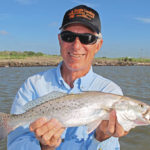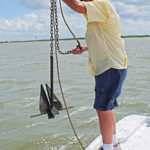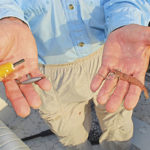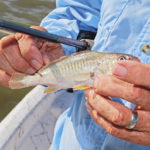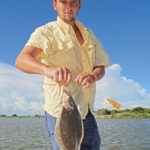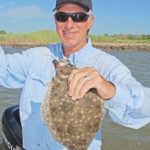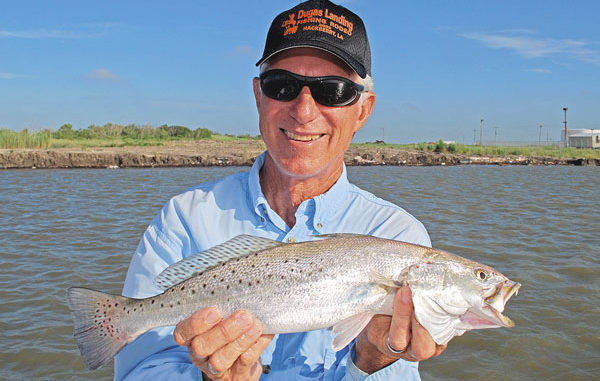
Want to catch lots of fish this month on Calcasieu Lake? Then leave your artificial baits at home.
The slender 67-year old silver-maned man waved his cooking utensil for emphasis as he spoke.
“I have no confidence in artificials,” he said. “I have always been a live-bait fisherman.”
Dale Weiman was in the kitchen of his fishing camp in Hackberry, on the western shore of Calcasieu Lake.
Although Weiman lives in Cold Springs, Texas, he counts as an honorary Louisianan, spending 50 to 60 days a year at the camp.
“I love it here,” he proclaimed emphatically. “The real secret is so much the fishing. This is the way I remember coastal fishing — rural, laid back.
“I’ve fished all over Texas — Port Isabel, Baffin Bay, Laguna Madre, Port O’Connor, Freeport, West Bay in Galveston, Trinity Bay and Sabine Lake. Other than Port O’Connor, this is better. I have caught thousands of fish in Port O’Connor.”
What’s changed?” I asked.
“People — the people,” he answered. “It’s run over by people. You can see 500 jet skiers and 500 sailboats; you can’t do anything out there without being run over.
“The population — too many people!
“The first time I came over here, I didn’t get on the water until 9 a.m., and I was completely lost. Me and two buddies caught 65 trout, two reds and two flounder. I was hooked.”
I knew that Weiman had won the Western Division of the CCA STAR Tournament last year with an 8.25-pound speck. I looked around the camp for the mount. Not spying it, I asked him if he had it at his home in Texas.
Twanging broadly in his East Texas accent, he said, “I ate it. I cut it into chunks, and cooked it on the griddle. It tasted good.”
Weiman explained that he likes to fish for “eatin’ fish,” in spite of catching more than his share of sows. Three days before he caught his STAR-winning fish, on the very first day of the STAR tournament, he caught, and ate, a 7.6-pound speck.
“With catching the big one so early in the tournament, I had to sweat 120 days out,” he said with a grin. “Every Tuesday night when I got in for three months, I checked the leader board. An 8.2-pound fish came in second.
“I attribute winning to keeping my fish alive all the way until it was weighed. Five-hundreths of a pound ain’t much.”
His discourse was interrupted by the wind whipping the outside of the elevated camp. It had been blowing since mid day, and was predicted to continue to blow. A weak hurricane was moving into the upper Mexican coast.
The whipping wind was sapping my confidence. I really wanted to see how a person can cast net his pogies and mullet and rod and reel the croakers that he uses for bait without moving from the spot he is fishing for trout, especially big trout. He caught his STAR winner with a pogie that he cast-netted from the bow of his anchored boat right before hooking it on his line.
“I usually start with some live shrimp, both to catch trout and to catch my croakers,” he said. “I don’t want those little croakers that they sell at the bait shop. I want 5- or 6-inch croakers. Hardheads eat the little ones.”
The wind was still huffing from the southeast when we went to bed. My confidence was ebbing.
Weiman’s 20-year old grandson, Jeffrey Weiman, arrived during the night. Dark-haired, dark-eyed and tanned, the goateed young man was the picture of an outdoorsman.
“I’ve fished with Grandpa as long as I can remember,” he said.
By morning, the wind had changed. It was now blowing from the northeast, and was even stronger. My confidence was flushed away.
The early morning sun shined like burnished gold as the boat that the elder Weiman had won in the tournament ran south in the protected water of Joe’s Pocket. In the boat’s live well was a good supply of live shrimp and the six largest croakers that Dale gleaned from the bait dealer’s tanks.
High spoil banks on the western side of the Calcasieu Ship Channel kept the water from being choppy. But it was dirty; in fact, it was cruddy.
Catching me looking at the water disconsolately, Dale tried to comfort me by explaining that the silt suspended in the lake’s waters are of a large particle size and that if the wind were to lie down, the water would very quickly clear up.
They stopped the boat at a large concave pocket eroded out of the marsh.
“This isn’t really one of our fishing holes,” Dale said, “but we always catch a few fish here by drifting across the pocket. You can do it any time of the day, but some days are better than others.”
Each man hooked a shrimp through the horn on top of its head with a 2/0 kahle hook. Between the 18- to 20-inch monofilament shock leader and the reel’s main line, each had a 1/2-ounce weight with a swivel. Slightly above each leader was a slotted unweighted popping cork.
As the boat drifted crossways, both men methodically cast downwind, then retrieved their rigs with a popping motion. On the third cast, Dale hooked up and landed a 14-inch speck. On the next cast, it was Jeffrey’s turn.
The water looked icky, but both men slowly picked up specks. None were giants, with the biggest being no more than 16 inches, but the sound of fish thumping in protest in the ice chest was gratifying.
Soon they tired of the spot, and got antsy to go to one of their “holes.” They headed south, and soon popped out from behind the ship channel’s spoil bank, and were hit by the full force of the wind-driven waves. It was a bouncy ride.
Past the pogie plant on the western shore of the ship channel but before the beginning of the rock jetties that extend out from the mouth of the channel, Dale slowed the boat and pulled into a rather nondescript piece of shoreline. It seemed to resemble any other stretch of bank on that side of the channel.
After Jeffrey dropped the anchor and the boat settled down within casting distance of the shoreline, Dale explained the plan.
“I’ll throw out my bottom rig with a big croaker on it and lay the rod in the boat,” he said. “I never hold my bottom-fishing rig. I let the fish do the work, but I’ll watch it real close.
“The rod I hold in my hand will be my popping-cork rig, the same one that I used drifting, and I’ll have a live shrimp on it.”
The idea is to cast the corked rig into the shallows and let the current in the channel sweep the shrimp along the shore.
Before he deployed his bottom rig, he cast the popping-cork rig to within 6 feet of the bank. Before the current could move the cork 6 inches, it instantly went under, and Dale retrieved a good speck.
The two anglers produced several specks without a break in the action before Dale laid his popping cork rod aside to set out his bottom rig. What Dale called his bottom rig was actually a freeline, the simplest of rigs. It was simply 2 feet of 30-pound-test leader with a large swivel on one end and a 6/0 kahle hook embedded in front of the croaker’s tail on the other.
Dale flipped out the freeline very near the spot that he caught his STAR-winning trout last year. Then he went back to his popping-cork rig. Jeffery had pulled ahead while Dale was fiddling with his croaker rig, and had just landed a keeper flounder.
“We catch a lot of flounder here, mixed with the specks,” said Dale. “Where we are casting now is on a flat near the bank 1½ to 2 feet deep. The tide is high today, but we fish here when the tide is low too. We just back off some and fish farther away from the bank.”
“It’s so easy to fish here,” chimed in Jeffery. “The cork just drifts along the shoreline, and when it stops, it’s a flounder on it.”
Before long, I could differentiate a flounder bite from a speckled trout or redfish bite. The latter two fish grab the shrimp and actively pull the cork under. Flounder simply hold the shrimp in their mouths and the cork stops, slowly leans over and then is gradually swept under by the tide-driven current.
Knowing the difference is important. The instant strike so important for hooking a speckled trout or redfish will pull the hook from a flounder’s mouth almost every time. When the bite is obviously from a flounder, both men seemed to count to at least 10 before setting the hook.
Mixed in with the specks, reds and flounder are 5- and 6-inch croakers, just as Dale had predicted. These go in the livewell. But today wasn’t to be the day for a big speck. Dale repeatedly rebaited the freeline with fresh croakers and cast them into different spots, but no dice.
Fortunately, the men’s popping cork rigs kept them hopping. The flounder bite seemed to grow stronger as the morning wore on. While Jeffrey watched his cork with fierce predatory concentration, Dale chatted about his fishing philosophy.
Tide charts?
“Don’t even look at them,” he said. “If I’m going fishing, I’m going fishing. If the water isn’t moving in my favorite spots, I’ll wait it out. This place is so good that sooner or later fish will move through here.
“I see boats stop here and catch a trout or two, then leave. We are patient, and at the end of the day, we have our trout limits, some flounder and a redfish or two. Riding boats is fun, but I’m a firm believer in having your bait in the water.”
Bait fish?
“I get excited when I see a mullet jump two or three times close to the water,” he said. “Something is after him. It’s not like when mullets are just flopping and jumping in the air.”
Fishing rigs?
“Something that makes a huge difference fishing like this is the depth setting of the cork,” he said. “I figured out real quick that I didn’t want to use those corks with swivels. I use the slotted kind that slide and I use the unweighted ones. I put the weight under the cork. Having the weight off the cork allows me to take the cork off and fish on the bottom. They are convenient.”
Noise?
“I can catch mullets and pogies by cast netting them off my anchored boat,” he said. “I will take them out of the net, hook them on my line and throw them out and catch fish right away. I used to think that the noise of a cast net scared fish, but not any more. That’s B.S.”
The elder Weiman was quiet for a moment, seemingly lost in thought.
“This is lazy man’s fishing,” he said. “All my life I have worked hard fishing — wading and so forth. This is so easy, and when the trout really bite the action is amazing.”
Throughout his grandfather’s expressions of opinion, Jeffery had been intensely fishing and catching fish. But Dale’s last comment prompted the quiet young man to add his view.
“With the whole lake to fish, we catch 90 percent of our fish here,” he said.
Dale half grimaced and half grinned.
“Man, there sure are some fish in here,” he said. “But I can’t understand why nothing will bite my croaker.”
